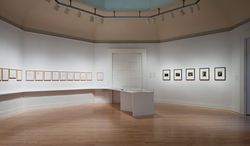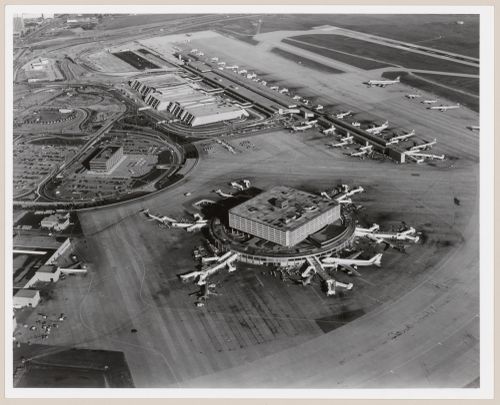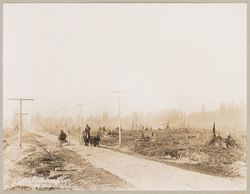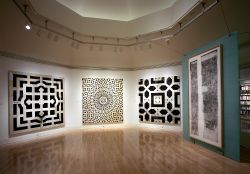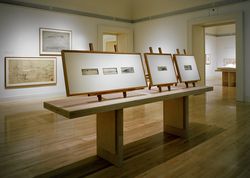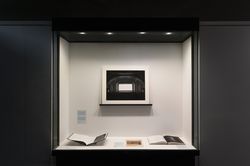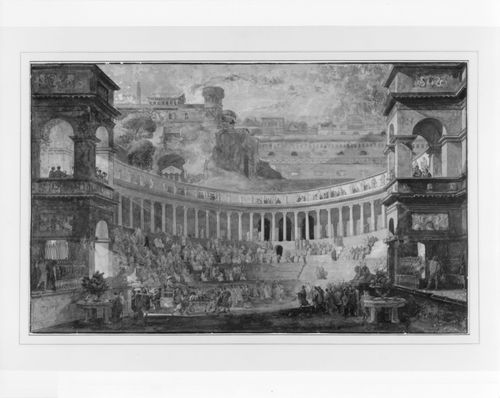L’architecte portugais Álvaro Siza s’est rendu en 1995 au Pérou, emportant dans ses bagages, comme à l’accoutumée, quelques vêtements, quelques livres de poésie et un seul carnet de croquis. C’était là son nécessaire pour interpréter son voyage et l’intégrer dans son architecture. Plus d’un demi-siècle auparavant, le photographe péruvien Martín Chambi avait réalisé des(...)
Salle octogonale
26 janvier 2012 au 29 avril 2012
Alturas de Machu Picchu : Martín Chambi – Álvaro Siza à l'œuvre
Actions:
Description:
L’architecte portugais Álvaro Siza s’est rendu en 1995 au Pérou, emportant dans ses bagages, comme à l’accoutumée, quelques vêtements, quelques livres de poésie et un seul carnet de croquis. C’était là son nécessaire pour interpréter son voyage et l’intégrer dans son architecture. Plus d’un demi-siècle auparavant, le photographe péruvien Martín Chambi avait réalisé des(...)
Salle octogonale
PH2009:0005:061
Description:
On verso of photograph, a handwritten note by photographer reads: "A copy from this series featuring original terminal no. 1 was selected by Carl Sagan to be placed aboard Voyager II for its flight to deep outer space. It is the sole canadian image carried".
architecture
1978
Toronto (Pearson) International Airport, Mississauga, Ontario
Actions:
PH2009:0005:061
Description:
On verso of photograph, a handwritten note by photographer reads: "A copy from this series featuring original terminal no. 1 was selected by Carl Sagan to be placed aboard Voyager II for its flight to deep outer space. It is the sole canadian image carried".
architecture
Maison Shaughnessy Mot(s)-clé(s):
chercheur en résidence 2022, séminaire, recherche, Desirée Valadares, infrastructure, chemin de fer, autoroute, histoire coloniale
10 novembre 2022, 18h
Maison Shaughnessy Mot(s)-clé(s):
chercheur en résidence 2022, séminaire, recherche, Desirée Valadares, infrastructure, chemin de fer, autoroute, histoire coloniale
L’exposition présente la quête de l’architecte américain Ben Nicholson pour l’ordre, le sens et la logique dans un monde où se mêlent art, science et mystère. La bibliothèque Laurentienne de Florence, un chef-d’œuvre conçu par Michel-Ange en 1524-1525, possède quinze paires de panneaux de terre cuite ornés de motifs géométriques complexes, panneaux qui furent longtemps(...)
Salle octogonale
11 décembre 1996 au 9 mars 1997
Découvrir la géométrie : Ben Nicholson et la bibliothèque Laurentienne
Actions:
Description:
L’exposition présente la quête de l’architecte américain Ben Nicholson pour l’ordre, le sens et la logique dans un monde où se mêlent art, science et mystère. La bibliothèque Laurentienne de Florence, un chef-d’œuvre conçu par Michel-Ange en 1524-1525, possède quinze paires de panneaux de terre cuite ornés de motifs géométriques complexes, panneaux qui furent longtemps(...)
Salle octogonale
documents textuels, photographies
DR2012:0012:085:004
Description:
File containing documents in French, including 2 colour slides, correspondence, notes, photocopies from « Trois: revue d'écriture et d'érudition » (vol. 6, nos. 2-3), and a program related to the exhibition "Corriger les lieux, après la photographie de voyage" at the Maison de la culture Frontenac in Montreal. Original folder inscribed in graphite: DAZIBAO: CORRIGER LES LIEUX AVRIL, 1991
1990-1991
Photographs, correspondence, notes, and a program related to the exhibition "Corriger les lieux, après la photographie de voyage"
Actions:
DR2012:0012:085:004
Description:
File containing documents in French, including 2 colour slides, correspondence, notes, photocopies from « Trois: revue d'écriture et d'érudition » (vol. 6, nos. 2-3), and a program related to the exhibition "Corriger les lieux, après la photographie de voyage" at the Maison de la culture Frontenac in Montreal. Original folder inscribed in graphite: DAZIBAO: CORRIGER LES LIEUX AVRIL, 1991
documents textuels, photographies
1990-1991
Le rapport révolutionnaire établi entre bâtiment et paysage, conçus ensemble selon des idéaux américains particuliers est au centre de Frank Lloyd Wright : Inventer un paysage américain, 1922-1932. Avec cette exposition, le CCA reconstitue cinq projets visionnaires qui ne devaient représenter rien de moins qu’un nouveau paysage, intégrant sur une vaste échelle terrain,(...)
Salles principales
18 juin 1996 au 29 septembre 1996
Frank Lloyd Wright : inventer un paysage américain, 1922-1932
Actions:
Description:
Le rapport révolutionnaire établi entre bâtiment et paysage, conçus ensemble selon des idéaux américains particuliers est au centre de Frank Lloyd Wright : Inventer un paysage américain, 1922-1932. Avec cette exposition, le CCA reconstitue cinq projets visionnaires qui ne devaient représenter rien de moins qu’un nouveau paysage, intégrant sur une vaste échelle terrain,(...)
Salles principales
Miroirs / Mirrors
Miroirs/ Mirrors prend forme à travers un dialogue indirect avec l’exposition L’histoire, par ailleurs: Go Hasegawa, Kersten Geers, David Van Severen, qui prend racine dans les références et les résonnances partagées entre les travaux de deux pratiques contemporaines mises en présence de l’histoire. Alors que L’histoire, par ailleurs se fonde sur limpression que lon a du(...)
Vitrines
22 juin 2017 au 14 janvier 2018
Miroirs / Mirrors
Actions:
Description:
Miroirs/ Mirrors prend forme à travers un dialogue indirect avec l’exposition L’histoire, par ailleurs: Go Hasegawa, Kersten Geers, David Van Severen, qui prend racine dans les références et les résonnances partagées entre les travaux de deux pratiques contemporaines mises en présence de l’histoire. Alors que L’histoire, par ailleurs se fonde sur limpression que lon a du(...)
Vitrines
archives
Niveau de description archivistique:
Fonds
Fonds Roger D'Astous
AP060
Résumé:
Le fonds témoigne des activités personnelles et professionnelles de Roger D'Astous, de sa carrière d'architecte et de sa contribution à l'architecture québécoise. Il nous renseigne sur sa formation académique à l'École des Beaux-Arts de Montréal, sur son séjour en tant qu'apprenti à l'atelier de Frank Lloyd Wright à Taliesin (Arizona et Wisconsin), ainsi que sur sa pratique professionnelle en tant qu'architecte. Ces projets professionnels sont principalement concentrés au Québec, à Montréal, en Montérégie, dans les Laurentides, à Laval, ainsi qu'en Ontario (dont à Brockville et à Kingston). Le fonds contient, entre autres, 4 100 dessins d’architecture, 2 581 documents photographiques, 7 maquettes et 1,23 m.l. de documents textuels.
1893-1998, surtout 1951-1998
Fonds Roger D'Astous
Actions:
AP060
Résumé:
Le fonds témoigne des activités personnelles et professionnelles de Roger D'Astous, de sa carrière d'architecte et de sa contribution à l'architecture québécoise. Il nous renseigne sur sa formation académique à l'École des Beaux-Arts de Montréal, sur son séjour en tant qu'apprenti à l'atelier de Frank Lloyd Wright à Taliesin (Arizona et Wisconsin), ainsi que sur sa pratique professionnelle en tant qu'architecte. Ces projets professionnels sont principalement concentrés au Québec, à Montréal, en Montérégie, dans les Laurentides, à Laval, ainsi qu'en Ontario (dont à Brockville et à Kingston). Le fonds contient, entre autres, 4 100 dessins d’architecture, 2 581 documents photographiques, 7 maquettes et 1,23 m.l. de documents textuels.
archives
Niveau de description archivistique:
Fonds
1893-1998, surtout 1951-1998
archives
Niveau de description archivistique:
Fonds
Fonds Robert Duchesnay
AP115
Résumé:
Le Fonds Robert Duchesnay consiste en une série de photographies montrant les divers structure (principalement des dômes géodésiques) conçus ou influencée par R. Buckminster Fuller. Les photographies, prises par l'artiste et photographe montréalais Robert Duchesnay, ont été créées entre 1985 et 1992.
1985-1992
Fonds Robert Duchesnay
Actions:
AP115
Résumé:
Le Fonds Robert Duchesnay consiste en une série de photographies montrant les divers structure (principalement des dômes géodésiques) conçus ou influencée par R. Buckminster Fuller. Les photographies, prises par l'artiste et photographe montréalais Robert Duchesnay, ont été créées entre 1985 et 1992.
archives
Niveau de description archivistique:
Fonds
1985-1992
The Triumph of Hannibal
DR1984:1641
Description:
- The turbaned figure being carried into the theater seated on a litter certainly refers to a non-Roman figure, possibly Hannibal. Behind this figure is a theater and an imaginary town on a hill. The town buildings recall the Sicilian monuments in the 'Voyage pittoresque ou description des royaumes de Naples et de Sicile' published by the Abbé de Saint-Non in Paris between 1781 and 1786. Desprez interrupted his studies at the French Academy in Rome from December 1777 to January 1779 to accompany Dominique Vivant Denon and several other artists to Naples and Sicily in order to make drawings for this publication. The town buildings also recall several buildings Desprez planned in Stockholm while stage designer and architect to Gustavus III of Sweden from 1784 to 1792.
design de théâtre
ca. 1780-1790
The Triumph of Hannibal
Actions:
DR1984:1641
Description:
- The turbaned figure being carried into the theater seated on a litter certainly refers to a non-Roman figure, possibly Hannibal. Behind this figure is a theater and an imaginary town on a hill. The town buildings recall the Sicilian monuments in the 'Voyage pittoresque ou description des royaumes de Naples et de Sicile' published by the Abbé de Saint-Non in Paris between 1781 and 1786. Desprez interrupted his studies at the French Academy in Rome from December 1777 to January 1779 to accompany Dominique Vivant Denon and several other artists to Naples and Sicily in order to make drawings for this publication. The town buildings also recall several buildings Desprez planned in Stockholm while stage designer and architect to Gustavus III of Sweden from 1784 to 1792.
design de théâtre
